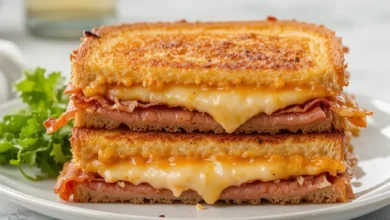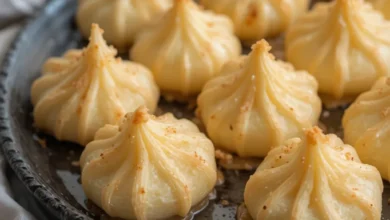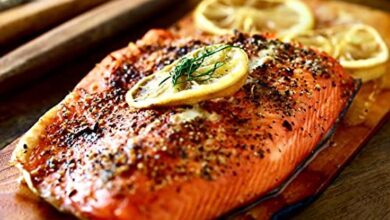Deep-Fried Deviled Eggs: The Crispy, Creamy Appetizer That Steals Every Show

A Classic Reborn
The deviled egg is a timeless treasure, a staple at family gatherings, potlucks, and holiday parties. Its creamy, tangy filling and familiar comfort are unmatched. But what if we told you this classic could be elevated to a whole new level of culinary delight? Enter the Deep-Fried Deviled Egg.
This innovative appetizer takes everything you love about the original and adds an incredible textural contrast. Imagine: a crisp, golden-brown, slightly crunchy exterior that gives way to a warm, velvety, and perfectly seasoned yolk center. It’s a surprising, decadent, and utterly irresistible creation that will have your guests begging for the recipe.
In this comprehensive guide, we will walk you through everything you need to know to master this dish. From boiling the perfect easy-to-peel eggs to creating a flawless breading station and crafting a filling that sings with flavor, we’ve got you covered. Get ready to transform a humble appetizer into the star of your next gathering.
The Science of the Sizzle: Why Deep-Frying Works
You might be wondering, “Why fry a deviled egg?” The answer lies in texture and temperature. The process of deep-frying creates a Maillard reaction on the surface of the egg white, resulting in a complex, savory, and crispy crust. This hot, crunchy shell beautifully insulates the filling, which becomes luxuriously warm and creamy.
The magic happens when the cold, filled egg hits the hot oil. The breading sets almost instantly, sealing in the moisture and preventing the filling from leaking out. The result is a harmonious bite where the hot, crispy outside melds perfectly with the rich, cool, and tangy interior. It’s a sensory experience that a standard deviled egg simply cannot provide.
Essential Equipment & Ingredients
Before we begin, let’s ensure you have the right tools and fresh ingredients for success.
Kitchen Equipment:
- A large pot for boiling eggs
- A slotted spoon or spider strainer
- A bowl of ice water
- A sharp knife
- A mixing bowl for the filling
- A piping bag or a zip-top bag with the corner snipped off (optional but recommended)
- Three shallow bowls for the breading station
- A deep fryer, Dutch oven, or heavy-bottomed pot
- A deep-fry thermometer (crucial for temperature control)
- A wire rack set over a baking sheet (for draining)
Ingredients for the Eggs and Filling:
- 12 large eggs, preferably a week old (they peel easier)
- 1/3 cup (80g) high-quality mayonnaise
- 2 tablespoons Dijon mustard
- 1 teaspoon white vinegar or pickle brine
- 1/4 teaspoon smoked paprika, plus more for garnish
- Salt and freshly ground black pepper to taste
- Optional Fill-Ins: 1 tablespoon sweet pickle relish, a dash of hot sauce, crispy chopped bacon, fresh chives, or a pinch of cayenne pepper.
Ingredients for the Breading Station:
- 1 cup all-purpose flour
- 2 large eggs, beaten with 1 tablespoon of water
- 1.5 cups Panko breadcrumbs (for maximum crunch)
- 1 teaspoon garlic powder
- 1/2 teaspoon salt
- High-heat oil for frying (canola, vegetable, or peanut oil work best)
Step-by-Step Cooking Instructions
Follow these steps carefully for perfectly fried deviled eggs every time.
Step 1: The Perfect Hard-Boiled Egg
Place your 12 eggs in a single layer at the bottom of a large pot. Cover them with cold water by at least an inch. Bring the water to a rolling boil over high heat. Once boiling, immediately cover the pot and remove it from the heat. Let the eggs sit in the hot water for exactly 10-12 minutes. Meanwhile, prepare a large bowl of ice water. After the time is up, use a slotted spoon to transfer the eggs directly into the ice bath to stop the cooking process. Let them cool completely for at least 15 minutes before peeling.
Step 2: Peel, Halve, and Separate
Gently tap each egg on the counter and peel under cool running water. Pat them dry with a paper towel. Using a sharp knife, carefully slice each egg in half lengthwise. Gently pop out the yolks into a mixing bowl and place the whites on a plate lined with paper towels to absorb any excess moisture. Arrange the whites cut-side down to help them dry further—this is key for the breading to adhere.
Step 3: Create the Creamy Filling
Mash the egg yolks with a fork until they form a fine crumb. Add the mayonnaise, Dijon mustard, vinegar, smoked paprika, salt, and pepper. Mix until the filling is smooth and creamy. If you’re using any optional ingredients like relish or bacon, fold them in now. For a super-smooth filling, you can push the mixture through a fine-mesh sieve.
Step 4: The Filling & Freezing (The Secret Step!)
This is the most critical step for success. Using a spoon or a piping bag, generously fill each egg white half with the yolk mixture, mounding it slightly above the edge. Once all eggs are filled, place the entire tray in the freezer for at least 30-45 minutes. Do not skip this! A semi-frozen filling is essential—it prevents the deviled eggs from falling apart or leaking during the frying process.
Step 5: Set Up Your Breading Station
While the eggs are chilling, set up your three-bowl breading station:
- Bowl 1: All-purpose flour, seasoned with a pinch of salt and pepper.
- Bowl 2: The beaten eggs with water.
- Bowl 3: Panko breadcrumbs mixed with garlic powder and salt.
Step 6: The Bread and The Fry
- Heat your oil in a deep fryer or heavy pot to 375°F (190°C). Use a thermometer to maintain this temperature.
- Remove the eggs from the freezer. Working with one egg at a time, dredge it first in the flour, tapping off the excess.
- Next, dip it into the beaten egg, ensuring it’s fully coated.
- Finally, press it firmly into the Panko breadcrumbs, making sure the entire surface is covered. Place the breaded egg on a clean plate.
- Carefully lower 3-4 eggs at a time into the hot oil using your slotted spoon. Do not overcrowd the pot, as this will cause the temperature to drop.
- Fry for 60-90 seconds, turning occasionally, until they are a deep, golden brown and crispy.
- Remove the eggs from the oil and let them drain on the wire rack. This keeps them crispy, unlike paper towels which can make them soggy.
Step 7: Serve and Impress
Let the fried eggs cool for just a minute or two—the filling will be delightfully warm. Arrange them on a serving platter, garnish with a sprinkle of smoked paprika and some fresh chopped chives, and serve immediately.
Pro-Tips for Frying Perfection
- Temperature is King: If the oil is too cool, the eggs will absorb oil and become greasy. If it’s too hot, the outside will burn before the inside is warm.
- Dry Your Whites: The drier the egg white surface, the better the breading will stick.
- Freeze, Don’t Skip: A firm, cold filling is your best insurance against a messy fry.
- Experiment with Flavors: Add crumbled blue cheese to the filling, or mix some grated Parmesan into the Panko for an extra flavor boost.
Conclusion: Your New Signature Dish
Deep-fried deviled eggs are more than just a recipe; they are a conversation starter and a testament to culinary creativity. They take a beloved classic and reinvent it with a thrilling crunch and a warm, creamy heart. While they require a few more steps than their traditional counterpart, the stunned and delighted reactions from your friends and family will make every moment worth it.
So, embrace the adventure, heat up that oil, and get ready to serve the most memorable appetizer of the year. The classic deviled egg will always have its place, but for a show-stopping bite that combines comfort with gourmet flair, the deep-fried version is truly in a league of its own.



